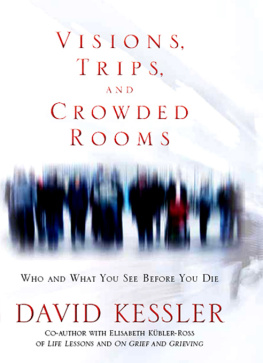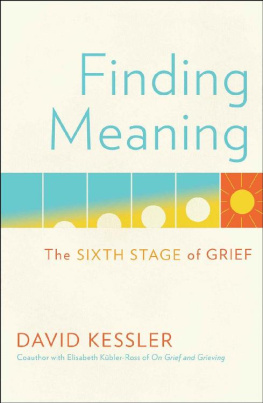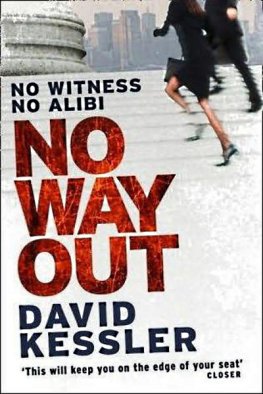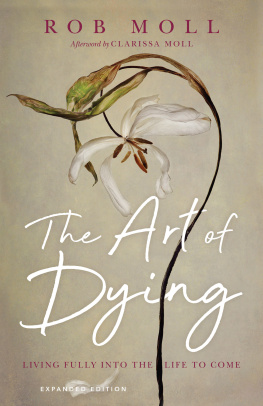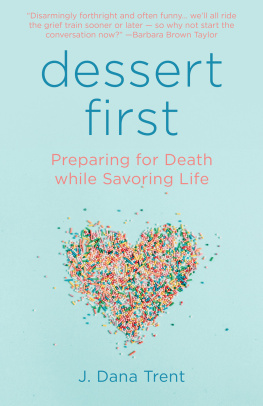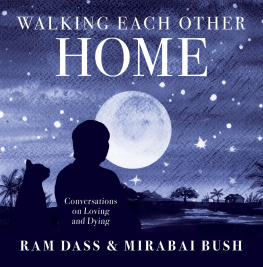
Praise for
Visions, Trips, and Crowded Rooms
David Kessler writes of a world that is rarely talked about,
much less examined with such sensitivity. His stories reveal
dimensions of the death experience that are anything but
depressing, and at times absolutely joyful. In a book filled
with intriguing and inspirational tales, Kessler makes a
compelling argument that death is not the end.
Marianne Williamson, the New York Times
best-selling author of The Age of Miracles
I so remember David Kessler in the old days of The Hayride,
a support group I started in West Hollywood. He and his work
were so vital and so heartwarming to our group, who shared
those frightening moments of crises in the early days of the
AIDS epidemic. His very presence with those approaching death
was like being enveloped in a safe, cozy space. No harm could
come to you if David was around. In fact, I recently asked
him to be there when it is my time to go. This book
shares Davids wisdom and his love, and helps all
of us who enter unknown waters.
Louise L. Hay, the New York Times best-selling
author of You Can Heal Your Life
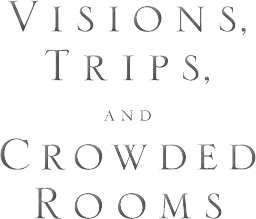
ALSO BY DAVID KESSLER
ON GRIEF AND GRIEVING: Finding the Meaning of Grief
Through the Five Stages of Loss
(co-authored with Elisabeth Kbler-Ross)
LIFE LESSONS: Two Experts on Death and Dying Teach
Us About the Mysteries of Life and Living
(co-authored with Elisabeth Kbler-Ross)
THE NEEDS OF THE DYING: A Guide for Bringing Hope,
Comfort, and Love to Lifes Final Chapter

Please visit:
Hay House USA: www.hayhouse.com
Hay House Australia: www.hayhouse.com.au
Hay House UK: www.hayhouse.co.uk
Hay House South Africa: www.hayhouse.co.za
Hay House India: www.hayhouse.co.in

Copyright 2010 by David Kessler, Inc.
Published and distributed in the United States by: Hay House, Inc.: www.hayhouse.com Published and distributed in Australia by: Hay House Australia Pty. Ltd.: www.hayhouse.com.au Published and distributed in the United Kingdom by: Hay House UK, Ltd.: www.hayhouse.co.uk Published and distributed in the Republic of SouthAfrica by: Hay House SA (Pty), Ltd.: www.hayhouse.co.za Distributed in Canada by: Raincoast: www.raincoast.com Published in India by: Hay House Publishers India: www.hayhouse.co.in
Editorial supervision: Jill Kramer Project editor: Lisa Mitchell
Design: Nick C. Welch
All rights reserved. No part of this book may be reproduced by any mechanical, photographic, or electronic process, or in the form of a phonographic recording; nor may it be stored in a retrieval system, transmitted, or otherwise be copied for public or private useother than for fair use as brief quotations embodied in articles and reviewswithout prior written permission of the publisher.
The author of this book does not dispense medical advice or prescribe the use of any technique as a form of treatment for physical, emotional, or medical problems without the advice of a physician, either directly or indirectly. The intent of the author is only to offer information of a general nature to help you in your quest for emotional and spiritual wellbeing. In the event you use any of the information in this book for yourself, which is your constitutional right, the author and the publisher assume no responsibility for your actions.
Library of Congress Cataloging-in-Publication Data
Kessler, David.
Visions, trips, and crowded rooms : who and what you see before you die / David Kessler.
p. cm.
ISBN 978-1-4019-2542-0 (hbk. : alk. paper) 1. Deathbed hallucinations. 2. Death-Psychological aspects. 3. Terminally ill--Psychology. I. Title.
BF1063.D4K47 2010
155.937--dc22
2009050707
ISBN: 978-1-4019-2542-0
13 12 11 10 4 3 2 1
1st edition, May 2010
Printed in the United States of America
For Richard, David, and India
CONTENTS
This book is the result of personal experiences of healthcare professionals and clergy members, as well as those who have lost loved ones. The contributors have not received any pay or recognition; rather, they have shared their stories in the hope that readers will come away less afraid and with a deeper understanding about what happens in our final moments of life. These firsthand accounts suggest that deathbed visions are normal and actually common, and they were culled from believers and skeptics alike, with no agenda. This book is simply a report from the front lines, featuring stories of average people, in their own words, experiencing extraordinary events.

(Editors note: All stories have been edited
for length and clarity.)
When people ask me what I do, I pause and cringe a little. Do I tell them that I write books on death and dying? Or do I tell them that I was first trained as a nurse and now I run a highly regarded and unique end-of-life program at the fifth-largest hospital system in Los Angeles? Do I explain that Im a specialist police reserve officer on the trauma team, as well as being a member of the Red Cross disaster team? Or that I trained for a pilots license and worked on two aviation disasters?
I know it can be confusing, so I often say that Im a hybrid of all those things. Unlike my mentor, Elisabeth Kbler-Ross, who mostly worked with death in the hospital setting, Im trained as a modern-day thanatologist; in other words, I dont only deal with death in the hospital or hospice, but also at crime scenes, plane crashes, and even bioterror attacks. I follow death wherever it calls me. When I look back on my reasons for following this unusual path, I see that my career choices werent random. It was my destiny to become who I am because of one particular day when I was 12 years old.
My mother battled health problems throughout much of my life. On New Years Eve 1972, I walked into her bedroom, where she was ailing. I gave her a kiss and said, Mom, 1973 will be the year you get better. Within days, as she endured severe kidney failure, she was transferred from our local VA hospital to one that was much larger and better equipped.
My father and I sometimes stayed at a hotel across the park from the hospital when we had the money. We mostly sat in the hospitals lobby since my mother was in an intensive care unit, which only allowed visitors every two hours for ten minutes. One morning we were on our way to see Mom when there was sudden activity around our hotel. Everyone outside began running as shots were fired. Evidently, there was a sniper on top of the building. Within seconds, police were everywhere while people rushed into the adjoining buildings for cover. It was actually pretty exciting stuff for a child who had been so bored sitting in the hospital for days on end.
Dad and I eventually made our way over to see Mom and were told that she didnt have long to live. She died alone that day, but thats the way it happened back then. Families (especially children) were often not allowed to be present during a patients final moments; and when they were, it was at the mercy of the caretakers. My mothers doctor reluctantly agreed to let my father see her, but said that I could not. When the nurse came to take Dad to Moms room, I went along, hoping I wouldnt get caught.
Next page
